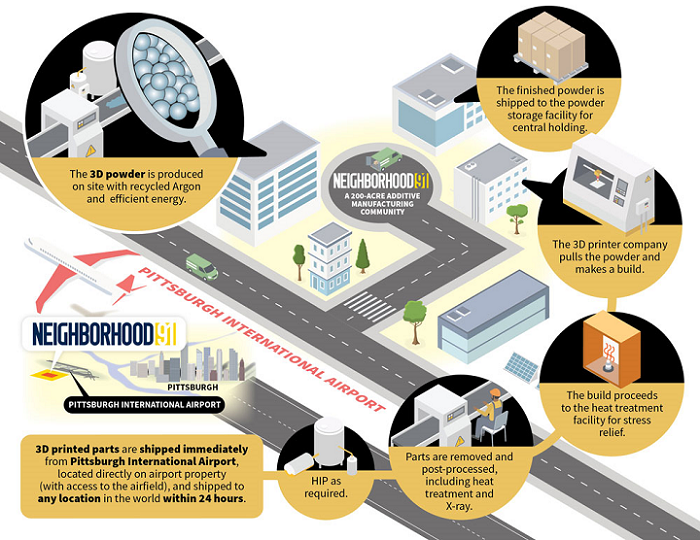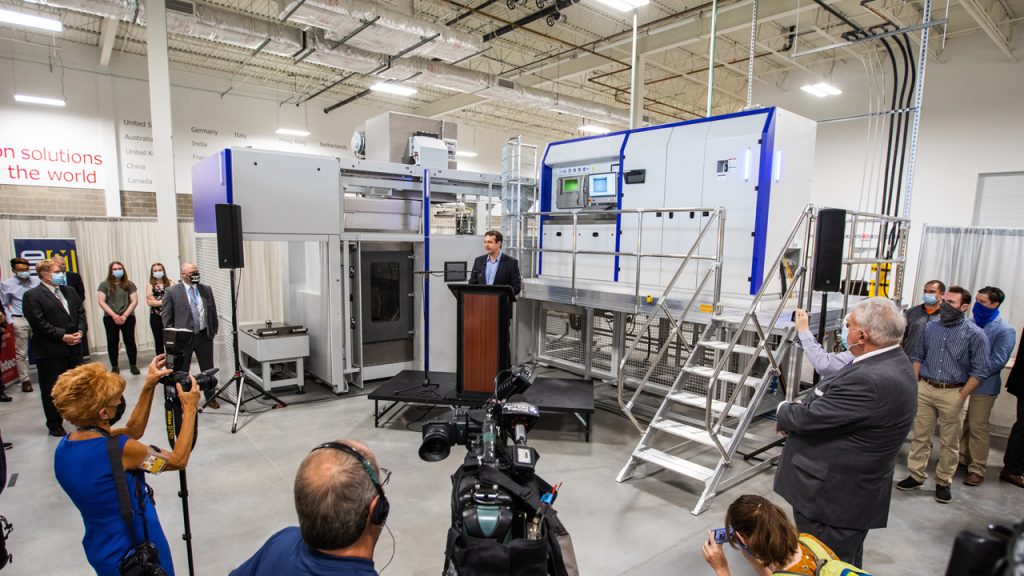After much anticipation, Wabtec Corporation (NYSE: WAB) has officially kicked off operations at its new 3D printing facility at Neighborhood 91, located at Pittsburgh International Airport’s Innovation Campus. The new 11,000-square-foot facility is dedicated to additive production and will be used to grow the rail company’s 3D printing capabilities.
The site already includes a large-scale SLM800 printer, which will be used to 3D print large-scale, lightweight parts for Wabtec’s customers in the rail industry. This includes aluminum items, such as brake parts, heat sinks for freight trains, and other components. The company believes that the use of 3D printing could cut lead times by up to 80 percent in some cases.
As discussed in our interview with Jennifer Coyne, formerly Wabtec’s global additive manufacturing (AM) leader, the firm aims to 3D print 25,000 parts by 2025 in support of its internal supply chain. The goal for the company is to simplify its supply chain, as well as incorporate design improvements, at a competitive price.
“Advances in additive technology are changing the way we design and build the next generation of business-critical, sustainable products for our customers,” said Eric Gebhardt, Wabtec’s chief technology officer. “Neighborhood 91 and its one-of-a-kind additive ecosystem will help foster creative solutions to engineering challenges and breakthroughs in 3D printing. Our Neighborhood 91 facility and the other additive labs in Western Pennsylvania will accelerate new innovations that shrink lead times, reduce cost and increase reliability.”
The new facility is part of Wabtec’s initiative to use additive manufacturing to provide parts faster with a simplified supply chain, applying advanced features that improve the application, all at a competitive price point. The company plans to use additive technologies to produce more than 25,000 parts by 2025 in support of the internal supply chain.
I’m excited both about Wabtec and Neighborhood 91. As noted in our recent 3DPrint.com PRO article, U.S. infrastructure is failing. And, while not always sustainable, rail transport is potentially a greener way to travel and, depending on a number of factors, transport goods across long distances. However, particularly when it comes to high-speed rail, the U.S. is severely lacking the rail department.
With about two-thirds of its business dedicated to freight and one-third dedicated to passenger rail, Wabtec is helping to modernize the U.S. rail industry. In addition to its aggressive additive program, the company is developing a 100 percent battery-electric locomotive. In May 2021, it announced the results of a test of its FLXdrive technology, in which a FLXdrive-powered train ran service across 13,320 miles in the mountainous San Joaquin Valley region of California for three months.
Wabtec determined that this battery-driven locomotive had 11 percent less fuel consumption and greenhouse gas emissions. Next, the firm will build a battery with over six megawatt hours of capacity, which is predicted to cut emissions and fuel consumption by 30 percent. The company aims to deploy a fleet of trains with this second-generation FLXdrive technology over the course of the next few years. In the long-term, Wabtec hopes to develop zero-emission locomotives using batteries, hydrogen internal combustion engines and hydrogen fuel cells, reducing the rail industry’s carbon footprint by up to 300 tons per year.
Neighborhood 91 is the very beginning of what could become a model for integrated industrial parks in the future. By locating businesses at the Pittsburgh airport, the campus could streamline product shipment, which could have some impact on emissions related to transportation of goods to and from the airport.

Neighborhood 91 will be the first site in the world to contain every element of the AM supply chain, from design to production and distribution. (Image courtesy of Neighborhood 91.)
Moreover, the site will feature argon gas recycling, through its first tenant, Arencibia. The company focuses on monitoring, analysis and recovery of noble gases, such as argon for 3D printing. By recycling argon gas used in metal AM, such as that performed by the SLM 800, Arencibia believes it can help reduce 60 percent of 3D printing costs associated with the use of argon or other noble gasses. Because Rusal America will also be a resident of Neighborhood 91, Wabtec may end up using the Russian company’s low-carbon ALLOW aluminum, which is smelted in factories largely run by hydropower.
Our industrial society is still far too far from ecologically sustainable operations, but Neighborhood 91 is a very small step in the right direction. It may not truly represent circular production and consumption, but it is essentially doing as best as possible within the existing economic and manufacturing paradigm. Perhaps the next industrial park inspired by Neighborhood 91 or a future upgrade to the existing Pittsburgh campus will move even closer to complete industrial symbiosis.
For whimsical inspiration for an integrated production facility, consider looking into the Solimene Ceramics Factory in Vietri sul Mare, Italy, built in 1954 by Paolo Soleri. Both a workers’ residence and ceramics manufacturing site, the building was designed in such a way that production line spirals top-to-bottom from beginning-to-end.
Subscribe to Our Email Newsletter
Stay up-to-date on all the latest news from the 3D printing industry and receive information and offers from third party vendors.
You May Also Like
Further Understanding of 3D Printing Design at ADDITIV Design World
ADDITIV is back once again! This time, the virtual platform for additive manufacturing will be holding the first-ever edition of ADDITIV Design World on May 23rd from 9:00 AM –...
3D Printer Maker EVO-tech Reborn as NEVO3D — Once More With Feeling
EVO-tech was a 3D printing service and original equipment manufacturer established in 2013 and based in Schörfling am Attersee, Austria. The company produced high-quality material extrusion systems featuring linear bearings,...
3D Systems Brings 3D Printed PEEK Cranial Implant to the U.S. with FDA Clearance
For more than 10 years, 3D Systems (NYSE:DDD) has worked hand-in-hand with surgeons to plan over 150,000 patient-specific cases, and develop more than two million instruments and implants from its...
CDFAM Returns to Berlin for Second Annual Symposium
The second CDFAM Computational Design Symposium is scheduled for May 7-8, 2024, in Berlin, and will convene leading experts in computational design across all scales. Building upon the first event...

































